On a fine afternoon in 1752, word reached King Charles III of Bourbon that his royal archeologist, Karl Weber, had discovered a treasure trove at Herculaneum. Sometime earlier, his excavation tunnels had brought to light the luxurious residence that would later be dubbed the Villa of the Papyri, however on that particular day his tunnels broke into a long porticoed garden in the villa that was filled with statuary. In the dim underground light, it was impossible to see details, but the architect dutifully sent word of his remarkable find. The king and his party, who happened to be hunting in nearby woods, rushed to the scene and set to picnicking while they waited for slaves to carry pieces to the surface.
In her book, Pompeii Awakened: A Story of Rediscovery, author Judith Harris relates what occurred next:
“Amidst a flotilla of courtiers in silks and befurred velvet finery, Charles and his Prussian wife Queen Maria Amalia arrived in a rustling, stately procession and took their seats on folding chairs. From the bowels of the earth the carved white marble group of two embracing figures, which Weber had found in the Great Peristyle, appeared at the mouth of the tunnel, borne upon a litter carried by prison labourers. A shiver of excitement rippled through the court. Already the dainty turn of that horn revealed the prized Greek look. When the whole sculpture group hoved into view two heads could be seen and two bodies. One seemed to be a man of sorts, though at closer look he wore two small horns on his head. He gazed fondly into the female’s languid marble eyes. For locked in his embrace was a female goat, surely the prettiest in the flock, whom he was in the act of penetrating.”
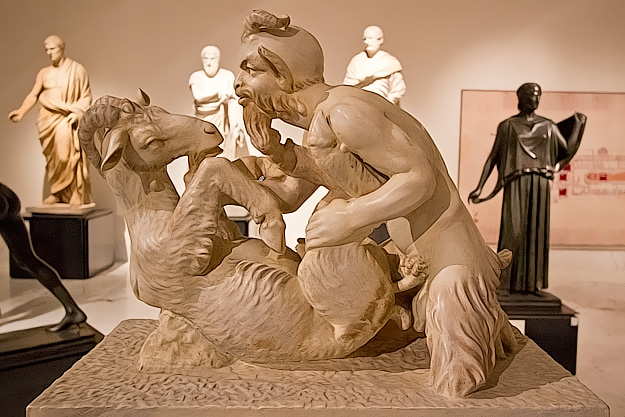
The king was horrified by the marble sculpture of the half-human, half-goat god Pan engaging in sex with a she-goat. He hastily led the party away from the site, ordering the sculpture to be locked in a cabinet at the Herculaneum Academy in Naples, where only those with express written permission from the King were allowed to view it. Charles’ attempt to suppress what he considered vulgar was doomed from the beginning. Prohibition fueled desire to see the erotic art and soon forgers were producing frescoes dominated by phallic figures, which were sold to tourists. Sketches of the famous Pan and the Goat sculpture were published and distributed freely. Copies were made of the most sexually explicit items. Upper class gentlemen, whose education was considered incomplete without a Grand European Tour, were soon adding Naples to their itinerary.
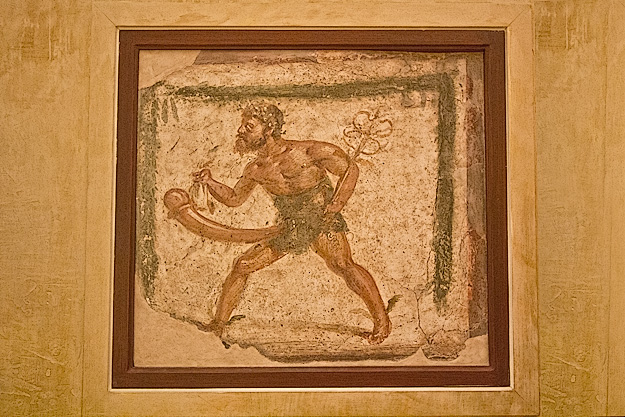
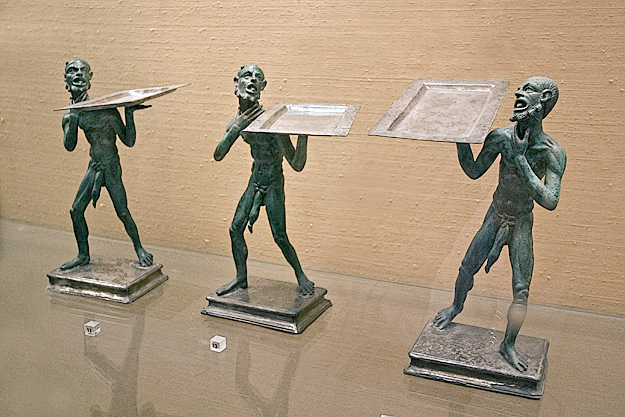
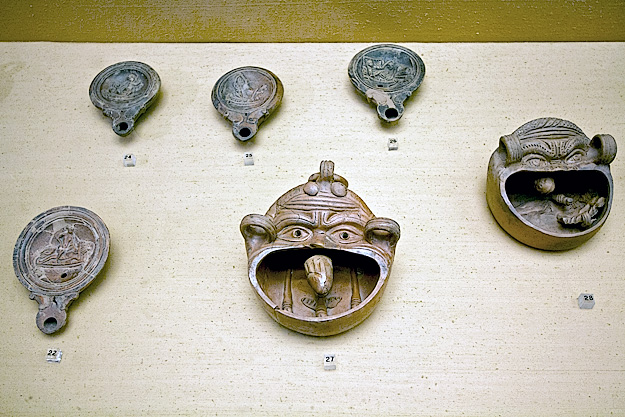
The discovery of such explicitly sexual pieces stunned archeologists, who had always assumed that ancient Rome was a morally upright society. Indeed, the belief that the Roman Empire fell as a result of moral depravity grew out of the discoveries of erotic art of Pompeii and Herculaneum, yet experts were puzzled that minimal evidence of a sex trade had been found in excavations of the Roman capital. The answer to this puzzle lies with the eruption of Mount Vesuvius in AD 79. History tell us that Caligula, the third Roman Emperor, imposed a tax on prostitution in AD 40. He essentially made sex a state sanctioned business and even installed a brothel in the palace. No less depraved, Nero, who became the fifth Roman Emperor 14 years later, arranged orgies for members of the aristocracy. Smaller towns such as Pompeii and Herculaneum followed suit, mimicking society in the capital. Roman mores began to shift in AD 69, when the more conservative Vespasian rose to power but his influence was just beginning to have an effect when the volcano blew its top. Pompeii, with its 41 brothels and scores of establishments where the sex trade thrived (public baths, theaters, tabernas, and private sex clubs), was frozen in time, while the parts of the Roman Empire unaffected by the eruption evolved into a more moderate society.
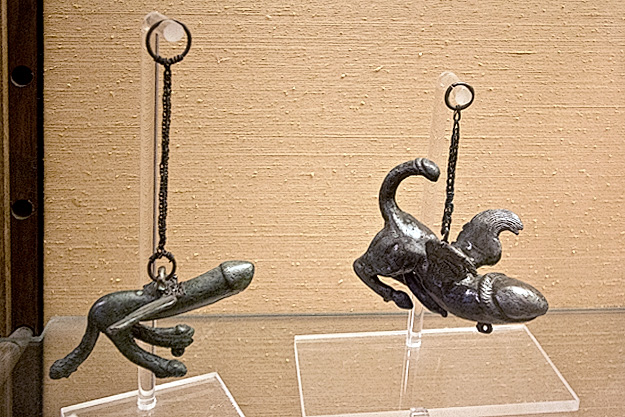
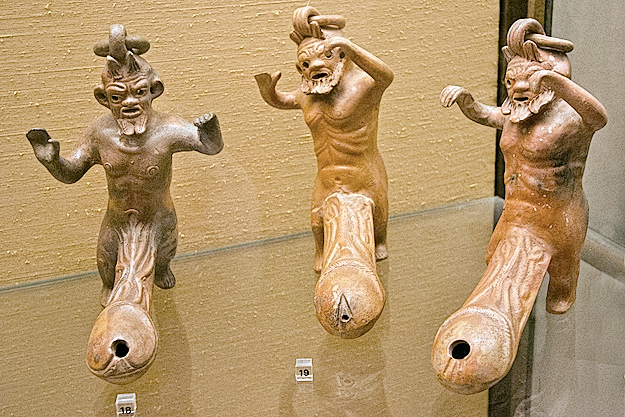

Hundreds of erotic art pieces continued to emerge from the digs during the Bourbon reign, especially at Pompeii. Frescoes of couples in various lovemaking positions, discovered on the walls of interior villa gardens, titillated banquet guests. These same guests were often gifted with amusing and suggestive penis-shaped party favors. Phallic symbols were also believed to ward off evil and ensure prosperity. Reliefs of phalluses were found mounted at the entrance to bakeries and on their ovens, while others were carved into walls and paving stones. In some cases, enormous erect penises protruded from the exterior walls of houses. As fast as they emerged, Charles locked away the vulgar items but in 1758 his successor, King Ferdinand of Naples, began allowing limited viewing by special permission. By 1819 the collection had been permanently transferred to what is today the Naples National Archaeological Museum, where it was put on public display. That more liberal stance was short lived. In 1827, two years after ascending to the throne, Francis I bowed to pressure from a priest and moved the display into a locked room, the Gabinetto Segreto (Secret Cabinet), which was opened only to “people of mature age and respected morals.”
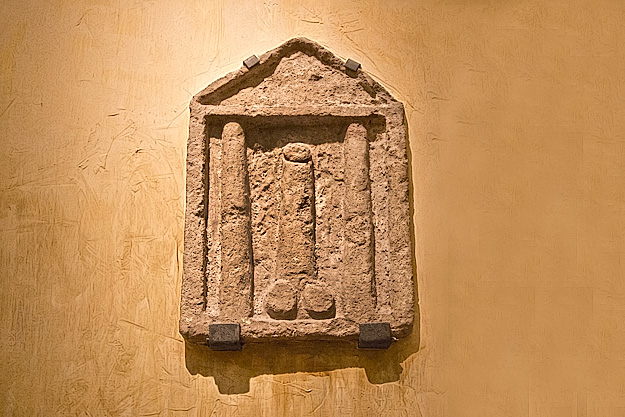

The assemblage of erotic art remained locked away for most of the next 173 years, emerging for about a year in 1848, again in 1860 after Garibaldi defeated the Bourbons, and briefly in 1976 before it was closed for restoration. The collection languished behind locked doors until 2000, when the Secret Cabinet was finally re-opened to the general public. Viewing that was once restricted to adult men of high moral character is now open for all to see, at least those over 14 years of age. Many of the frescoes are faded and hard to see clearly in the darkened room, but even in poor lighting the subject matter is graphic, wildly sensual, and slightly disturbing, but none so much as the statue of Pan copulating with a goat.
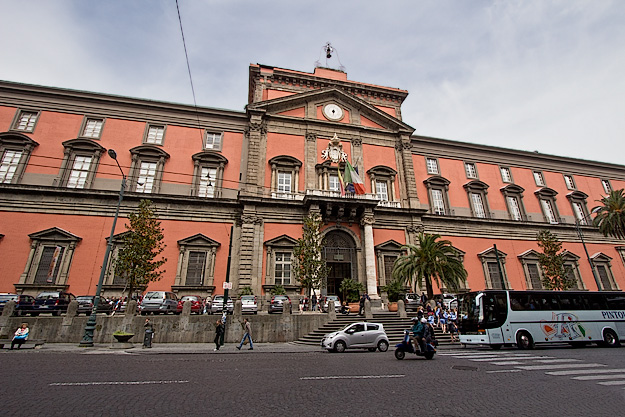
View the Erotic Art of Pompeii and Herculaneum in the Gabinetto Segreto (Secret Cabinet) at the Naples National Archaeological Museum:
The museum is open from 9 a.m. to 7:30 p.m., with the last ticket sold at 7 p.m. It is closed on Tuesdays. The Gabinetto Segreto (Secret Cabinet) can be visited between the hours of 9 a.m. and 7 p.m., “except on Sundays during the summer months and in case of shortage of staff,” according to their website, however I suspect that hours of operation are much less structured than indicated. The Gabinetto Segreto was locked and dark on the morning I arrived, and museum staff indicated it would be closed for the remainder of the day. Two hours later I checked again and it was open. Their website also states that it is necessary to schedule a 15-minute appointment to view the erotic art of Pompeii and Herculaneum, during which you will be accompanied by a guide who will provide an explanation in either Italian or English. However, I was not required to make an appointment nor was I accompanied by a guide. Ticket prices are as follows: Full price: 8 Euro (~$11), EU citizens between the ages of 18 and 24: 4 Euro (~$5.50), and free for EU teachers and EU citizens under the age of 18 and over 65.
Subway line one stops directly in front of the museum and the Cavour stop on line two is located just a block away from the museum. Visitors should always stay aware when using public transportation when traveling, but perhaps even more so in Naples. The city’s reputation for high crime is exaggerated, but pays to watch your belongings. I found this article on The Broke Backpacker blog helpful in answering the question, “Is Naples a Safe Travel Destination.” As for me, I found the city to be no more or less dangerous than most of the thousands of cities I’ve visited around the world.

I found your article absolutely fascinating. What I find so sad is how our society looks upon any sex as wrong. That the human image no matter how explicit should be celebrated not hidden away.
Rome did not fall because of Sex it fell because the government became too corrupted. Just as it is today, the government wants to control everything for the public but the hypocrites of government then keep it for themselves with their holding control. Shameful.
I went to Herculaneum and was surprised at the baths with erotic tiles but this amount shows why the legions had plenty of young men . The Legions were renowned for their off spring across the empire. Just a sign of the times I guess.
I never really considered that angle Andrew. Interesting thought.
As a little girl in the ’50s, living in Naples; and, as a teenager in the ’60s, living in Rome, we would go to Ercolano and Pompeii when we had family come to visit. I remember going to Ercolano several times and always having to stand outside a building/room that only adults could enter. (I don’t recall having to stay out of any rooms in Pompeii.) I finally see why. Thank you for enlightening me.
What a delightful story Eva. Thanks so much for sharing it. Made me laugh out loud!
I just found this thread after searching for whatever it was at Pompeii that was so racy. Last year, I found a series of pleadings in a divorce court filed by my great grandfather against my great grandmother in London England in 1906. She had a good defense, reciting a number of specific examples of intolerable conduct by her husband during a trip to Italy with several adult friends and family. Here is the one that made me look into this:
In May 1900 at Pompeii, after visiting a part of the ruins to which only men are admitted, the Petitioner made the following remark in the presence of [his wife’s sister and her sister’s husband] and several tourists including the Respondent and other ladies, “I have seen a dozen ways of doing it, which I am going to try on [my wife].”
While the exhibit was apparently restricted to ADULTS in the 1950s, clearly it was MEN ONLY in 1900.
My great grandfather lost his petition.
Thanks for sharing the info, keep up the good work going…. I really enjoyed exploring your site.
I wasn’t aware that Nero succeeded Caligula. An honest error that I thought needed pointing out; otherwise an excellent site.
Hi Wayne: You are absolutely right! Caligula was succeeded by Claudius. Nero came after Claudius. I’ve corrected the mistake. Thanks so much for pointing it out. I always do my best to make sure the historical facts are correct, but occasionally I miss something and I appreciate input when that happens.
Thank you on a detailed impressive guide! Saved your post for the future ?
In 1972 .visiting Pompii, we were allowed into a small room to see a standing statue of a naked youth with an erect penis.The guide said this was the ladies’ room.Visiting again in 2006 I noted that the statue was no longer there.It was not in the Naples museum. What happened to it?
Hi Brian: Well, I don’t know for sure, but if I had to guess I’d say that like most museums, they don;t have room to display their entire collection at all times. Perhaps the piece you originally saw had just been rotated out of the public displays when you were last there.
And I thought all that was buried at Pompeii were homes and baths. Very, very interesting to say the least, Barbara. So interesting how fertility was seen with such reverence back then mostly because of the mystery of how everything with the body worked. I will definitely be looking up when I visit my next bakery in southern Italy!
Hi Leslie. I also found it fascinating how views of fertility have changed over the ages. During the days of Pompeii it was revered, but modern day society has reviled it until recently. Glad you enjoyed my story.
Pretty pedestrian compared to what you find in Khajuraho, India
Looks like someone always has to own a bigger phallus.
Thank you so much for sharing this knowledge and these photos.
You’re welcome, J.L.S. Glad you enjoyed the story.
Thanks for uploading such great photos! I’m currently putting together a presentation on the Gabinetto Segreto for a postgraduate Art History paper and was wondering if you would mind me using them to demonstrate how the artifacts are displayed? Sadly my photos didn’t turn out as well from my trip last year. It’s been an incredibly interesting topic to research, especially the collection’s heavily censored past and the way Stefano De Caro has chosen to curate the exhibition. Funny to note that the infamous statue of Satyr and Goat was out on a main floor and not tucked away in the ‘Gardens’ section like it has been previously displayed!
Hi Maree: I’m happy to have you use my photos as long as they are properly attributed as such: “Photos courtesy of Barbara Weibel at Hole in the Donut Cultural Travel” Additionally, if they are to be used online, yu must link back to my blog, using the url https://holeinthedonut.com
Great read.I visited Pompeii years ago and remember taking a shot of a penis carved into the street stones.
It was at the intersection of the ‘Redlight’ District .
Each Profession had it’s own area.
It was either indicating a Brothel or Plastic Surgery – They had everything else back then!
Wish I’d seen the penis carving on the street corner, Rob, but somehow I missed it, as I did the one carved in the street.
This is fascinating Barbara…
I thought so too, Siddhartha.
My mother, brother, and I visited Pompeii many years ago, it the late 1960’s. There was a room in one of the villa that was locked. You had to pay to get into it. My mother tried to pay to see it and was told she wasn’t allowed entry because she was a woman. She was so furious! I have always wondered what was in that room! I feel sure that it may have been what was in one of your pictures, “Fresco of Priapus, son of Aphrodite and god of fertility and growth, found in a villa in Pompeii.”
Thanks for the memories! Wonderful web site and story!
Hi Virginia: I feel certain that the artwork referenced in my article is one and the same with the locked room your mother was not allowed into. As I was conducting research I came across numerous references to frescoes in the villas that had been covered with locked cabinets, etc. Thanks so much for taking the time to comment. I especially love it when my readers add details of their personal experiences that coincide with what I’ve written, and your comment about it being a “wonderful web site” made my day 🙂
Very interesting… Wonder if people later thought the volcanic eruption was “divine punishment” for Pompeii’s “loose” morals. The marble statue of Pan looks like a beautifully created masterpiece.
The most hilarious piece to me was the flying penis …. with a penis tail. Who knew the Romans were so horny all the time? 😉
Hi Katie: Yes, hilarious, but I think they had much healthier views abut sex than we have today 🙂
Healthier can be discussed, thinking of their use of sex slaves.
Uninhibited or more liberated might be a better wording.
\\\”…sex as a normal, healthy part of life…\\\” I agree with.
Great history lesson. I first came across this statue a few months back in college and i’m glad I was able to learn more about it, it’s really interesting.
Hi Clay: What most fascinated me was the fact that Romans did not think of this as pornographic in the least. They accepted sex as a normal, healthy part of life. It wasn’t until the Victorian age that this type of art really came under scrutiny and was labeled as socially unacceptable.
I recently stumbled upon your site and I’m so happy I did!
Your series on Pompeii is absolutely fantastic! I was there 2 years ago, but was so awestruck by what I saw that I kept forgetting to take photos. All your wonderful photographs have helped me remember all the amazing things I saw. Thank you from a new fan! 🙂
Hi Charity, and welcome aboard! Thanks so much for taking time to leave a comment and tell me how much you enjoy my photos – it meant a lot to me.
I’m surprised that it is so hard to see. When I went there, I simply walked into a room with all sorts of erotic art by accident. I hadn’t known that it was there beforehand – it had pan with goat amongst other things.
Hi Zoe: ILike you, I just walked in. But all the information on the museum’s website says you have to have a special appointment and a guide, and that you’re only allowed to be there for 15 minutes. Perhaps it was different for me because it was low season, I just don’t know.
Haha, I’d heard about this secret room, but you’ve given me all the benefit without the trouble of a return visit to Naples!
Glad to be of service, Heather 🙂